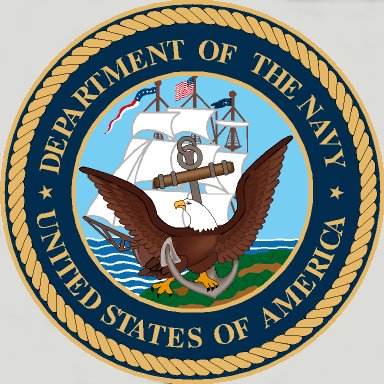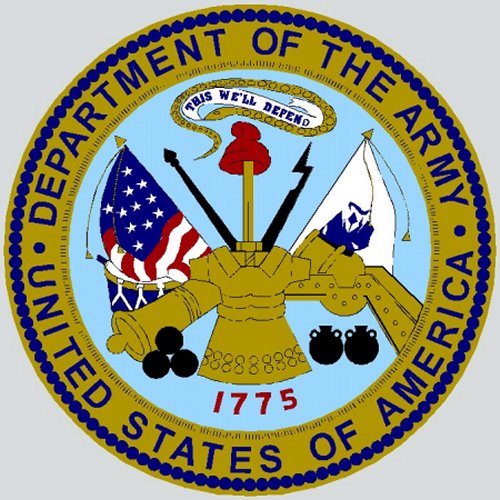Propulsion: Twelve double-ended and seven single-ended cylindrical boilers, four vertical quadruple-expansion steam engines, two shafts.
Click on thumbnail
for full size image | Size |
Image Description |
Source |
| SS Kaiser Wilhelm II |
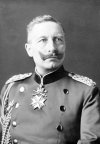 |
59k |
Namesake: Wilhelm II or William II (German: Friedrich Wilhelm Viktor Albert; 27 January 1859 – 4 June 1941) was the last German Emperor (Kaiser) and King of Prussia. He reigned from 15 June 1888 until his abdication on 9 November 1918 shortly before Germany's defeat in World War I |
Tommy Trampp |
 |
95k |
Undated postcard
Image by Themistokles von Eckenbrecher (1842 - 1921) |
Robert Hurst |
 |
83k |
Tobacco card was issued by Ogdens Ltd. in the U.K. in 1902 and came from a set entitled "Ogdens Guinea Golds" New Series 1 |
Tommy Trampp |
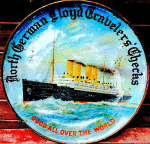 |
91k |
Antique 24" diameter advertising sign for North German Lloyd Travelers Checks with image of SS Kaiser Wilhelm II |
 |
288k |
c. 1903
Photo from "Passenger Liners of the World Since 1893" (1979) by Nicholas T. Cairis |
 |
106k |
Port side view of SS Kaiser Wilhelm II underway on 16 June 1906, operating between Bremen, Germany and New York, New York
Historic New England, Nathaniel L. Stebbins Collection, Photo PC047.02.4280.17152 |
Mike Green |
 |
268k |
Post card dated 24 June 1910 |
Tommy Trampp |
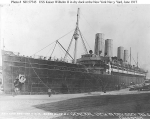 |
156k |
In Dry Dock Number Four at the New York Navy Yard, 18 June 1917, while being refitted for U.S. Navy service
Naval Historical Center photo NH 57745 |
Robert Hurst |
| USS Kaiser Wilhelm II (ID 3004) |
 |
68k |
Kaiser Wilhelm II fitting out for Navy service at the New York Navy Yard, Brooklyn, New York, in August 1917. Note the large tent in the foreground, with several 110-foot submarine chasers under construction behind it
U.S. Navy Photo NH 93941 |
Naval Historical Center |
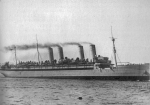 |
106k |
Underway following her commissioning into the U.S. Navy
Photo from "Great Liners at War" by Stephen Harding |
Robert Hurst |
| USS Agamemnon (ID 3004) |
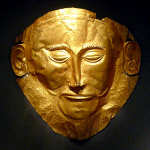 |
59k |
Namesake: In Greek mythology, Agamemnon was a king of Mycenae, the son of King Atreus and Queen Aerope of Mycenae, the brother of Menelaus, the husband of Clytemnestra and the father of Iphigenia, Electra or Laodike, Orestes and Chrysothemis. Legends make him the king of Mycenae or Argos, thought to be different names for the same area. When Helen, the wife of Menelaus, was taken to Troy by Paris, Agamemnon commanded the united Greek armed forces in the ensuing Trojan War. Upon Agamemnon's return from Troy, he was killed (according to the oldest surviving account, Odyssey 11.409–11) by Aegisthus, the lover of his wife Clytemnestra. In old versions of the story, the scene of the murder, when it is specified, is usually the house of Aegisthus, who has not taken up residence in Agamemnon's palace, and it involves an ambush and the deaths of Agamemnon's followers as well. In some later versions, Clytemnestra herself does the killing, or they act together as accomplices, killing Agamemnon in his own home
Photo is the so-called Mask of Agamemnon which was discovered by Heinrich Schliemann in 1876 at Mycenae, now believed to pre-date the legendary Trojan War by 300 years |
Tommy Trampp |
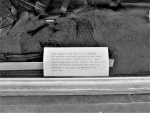 |
665k |
c. 1917
A pair of heavy winter gloves and a matching winter cap with ear flaps and a chin strap in the City of Newton's War Memorial Museum. They are identified in the display case as a pair of winter gloves and winter cap hand knitted by the Ladies Special Aid Society of the City of Newton, Massachusetts in 1917. The entire compliment of the troopship USS Agamemnon
(ID 3004), approximately 962 officers and crew, received a pair of these gloves and a cap for the frigid Atlantic crossings that were made by Agamemnon between 31 October 1917 and 18 August 1919. Making frequent stops in Boston Harbor, which is approximately ten miles from the City of Newton. Agamemnon carried 37,979 soldiers and sailors to Europe and brought 41,944 back |
David Hoover |
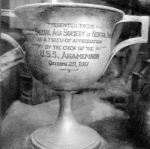 |
344k |
c. October 1917
A pewter cup in a display case in Newton's War Memorial Museum. This cup was "PRESENTED TO THE LADIES OF THE SPECIAL AID SOCIETY OF NEWTON, MA AS A TOKEN OF APPRECIATION BY THE CREW OF THE USS AGAMEMNON" |
 |
79k |
U.S. Navy Troop Transports at sea, 10 November 1917. These ships, steaming in convoy from New York City to Brest, France, are (from left to right): USS Mount Vernon (ID 4508), Agamemnon and USS Von Steuben (ID 3017). Note the damage to Von Steuben's bow, the result of a collision with Agamemnon on the previous day
Courtesy of Paul Silverstone, 1982
U.S. Navy photo NH 57750 |
Naval Historical Center |
 |
110k |
Halftone reproduction of a photograph taken in 1918-1919, showing the ship in port.
Donation of Terri D. Lewis, 2005.
Naval Historical Center photo NH 103101 |
Robert Hurst |
 |
57k |
Photographed from USS Warrington (Destroyer # 30) during World War I.
U.S. Navy Photo NH 77162 |
Naval Historical Center |
 |
42k |
Design sheets for the ship's port and starboard side camouflage pattern and also shows her bow-on aspect, circa 1918
U.S. Navy photos NH 57743 and NH 57744 |
 |
58k |
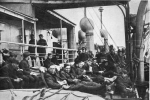 |
364k |
c. 1918
Sick and wounded American soldiers relax on the deck of the transport Agamemnon while homeward bound to America
Photo from "A History Of The Transport Service: Adventures And Experiences Of The United States Transports And Cruisers In The World War", by Vice Admiral Albert Gleaves, USN, Published by George H. Doran Company, New York |
Robert Hurst |
 |
67k |
Painted in Black, White, #3 Blue and #1 Blue-Grey, U.S. Navy Type N19, design A camouflage pattern
Imperial War Museum photo Q58240 from "Naval Camouflage 1914-1918: A Complete Visual Reference" by David Williams |
 |
111k |
Pitching her forefoot nearly out of the water, while steaming through rough seas during a trans-Atlantic voyage, circa 1917-1918. An escorting destroyer is in the left distance
Photographed by "HF Co"
Donation of Charles R. Haberlein, Jr., 2007
Naval Historical Center photo NH 105375 |
 |
91k |
Photographed from USS Mercury (ID 3012), while underway at sea in 1918
Courtesy of James Russell, 1980
U.S. Navy Photo NH 91645 |
Naval Historical Center |
 |
85k |
Arriving in Boston Harbor, Massachusetts, circa late 1918 or the first part of 1919, returning the U.S. Army's 102nd Infantry from Europe. USS SC-287 is at left.
U.S. Navy Photo NH 57479 |
 |
76k |
Arrives in Boston Harbor, Massachusetts, circa late 1918 or the first part of 1919, returning the U.S. Army's 102nd Infantry from Europe. She is being welcomed by submarine chasers and other vessels of the First Naval District.
U.S. Navy Photo NH 57480 |
 |
91k |
Arrives in Boston Harbor, Massachusetts, circa late 1918 or the first part of 1919, while returning the U.S. Army's 102nd Infantry from Europe. She is being escorted by ships and craft of the First Naval District. A submarine chaser is in the center foreground, and USS Machigonne (SP-1043) is at left, wearing a large welcoming sign
U.S. Navy photo NH 57481 |
 |
68k |
Steams into Boston Harbor, Massachusetts, circa late 1918 or the first part of 1919, while bringing the U.S. Army's 102nd Infantry home from Europe.
U.S. Navy Photo NH 57482 |
 |
157k |
Underway, circa late 1918, probably in the vicinity of New York Harbor
Panoramic photograph by E. Muller, Jr., New York
Courtesy of the Naval Historical Foundation. Donation of Lieutenant General John T. Myers, USMC (Retired), 1945
Naval Historical Center photo NH 105395 |
Robert Hurst |
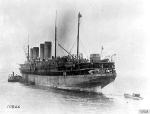 |
101k |
Arriving in Brest, France on 18 April 1918 loaded with American troops
Imperial War Museum photo © IWM(Q 52954) |
Mike Green |
 |
119k |
At the Norfolk Navy Yard, near Hampton Roads, Virginia, 15 February 1919. The patrol boat SP-1212 (ex-Inca) is on the pier at the extreme right
Panoramic photograph, taken by the G.L. Hall Optical Co., Norfolk, VA
Donation of the Norfolk Naval Shipyard Museum, Portsmouth, Virginia
U.S. Navy Photo NH 98558 |
Naval Historical Center |
 |
201k |
7 April 1919
Boston, Massachusetts
Arrival at Commonwealth Pier with the 26th ("Yankee") Division on board. SC-269 is in the lower left corner
Library of Congress photo LCUSZ62-52796 by Commercial Photo Shop, Lowell, MA |
Mike Green |
 |
126k |
7 April 1919
Stinger (SP 1252) off Agamemnon starboard quarter on her arrival in Boston, MA
Courtesy of Boston Public Library, Leslie Jones collection |
Boston Public Library |
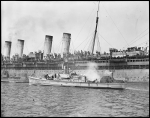 |
202k |
c. April 1919
Members of the U.S. Army's 26th Division arrive in Boston aboard the Agamemnon escorted by SC-138
Courtesy of Boston Public Library, Leslie Jones collection |
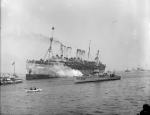 |
109k |
c. April 1919
Agamemnon sails into Boston's Commonwealth Pier with the 26th "Yankee" Division boys on board escorted by SC-408
Courtesy of Boston Public Library, Leslie Jones collection |
 |
125k |
Arriving at New York on 18 August 1919, bringing home from France Soldiers of the Eighteenth Field Artillery; Ninth Machine Gun Battalion; and Machine Gun Supply Companies of the 38th Infantry. A U.S. Army tug (left center foreground) is assisting the ship into her berth.
Panoramic photograph by Head-Mayberry, New York City
Donation of Dr. Mark Kulikowski, 2007
Naval Historical Center photo NH 105431 |
Robert Hurst |
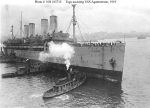 |
123k |
Being assisted by tugs in New York harbor, 1919
Donation of Dr. Mark Kulikowski, 2008
Naval Historical Center photo NH 105715 |
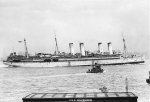 |
380k |
Arriving in a U.S. East Coast port while bringing troops home from Europe, 1919
Donation of Charles R. Haberlein Jr., 2009
Naval History and Heritage Command photo NH 106647 |
| USAT Monticello |
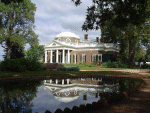 |
263k |
NamesakeMonticello was the primary plantation of Thomas Jefferson, the third President of the United States |
Tommy Trampp |
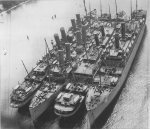 |
149k |
c. 1939
In the Patuxent River off Solomons Island, MD, four ex-German liners are laid up from left to right Monticello; USAT Mount Vernon, ex-USS Mount Vernon (ID 4508); USAT America, ex-USS America (ID 3006), ex-USS Amerika and USAT George Washington, ex-USS George Washington (ID 3018) |
Joe Radigan |
Commanding Officers
|
| 01 | CAPT Casey Bruce Morgan, USN - USNA Class of 1888
Awarded the Navy Distinguished Service Medal (1918) and the Army Distinguished Service Medal (1918) - Retired as Rear Admiral | 21 August 1917 |
| 02 | CAPT John Valentine Klemann, USN - USNA Class of 1895
Awarded the Navy Cross (1918) - Retired as Captain | 1918 - 1919 |
| 03 | CAPT David Foote Sellers, USN - USNA Class of 1894
Awarded the Navy Cross (1918) and the Navy Distinguished Service Medal (1929) - Retired as Admiral | 1919 |
Dictionary of American Naval Fighting Ships History: Agamemnon
Son of Atreus and brother of Menelaus, Agamemnon was the leader of the Greek forces arrayed against Troy in the Trojan War, described in Homer's epic poem, The Iliad. Some scholars believe that he was "a historical figure," a ruler of the Mycenaean or Achaean states of the Greek mainland.
Kaiser Wilhelm II—a steel-hulled, twin-screw express passenger steamship—was built for the North German Lloyd Line by Vulkan Aktiengesellschaft at Stettin.
Kaiser Wilhelm II made her first Atlantic crossing in 1903 and, for a decade, operated with speed and efficiency between Bremen and New York. She was at sea, en route to the United States, when World War I began on 3 August 1914. She reached New York on the 6th, arriving off the Ambrose Lightship with only her running lights showing and dispensing with the usual whistle signals. To evade capture by three British cruisers, she had kept within the three-mile limit during the last hours of the passage.
On 6 April 1917, the day the United States entered World War I, the collector of the Port of New York seized Kaiser Wilhelm II—along with 26 other German vessels—in New York harbor to prevent the ships' destruction at the hands of their crews. However, unbeknownst to the Americans, Kaiser Wilhelm II's crew had "commenced tampering with the machinery" as early as 31 January 1917. Her engineering plant had been extensively sabotaged; and two and one-half years of enforced idleness had not helped the condition of the engines.
Preliminary repairs were made at Hoboken, and on 22 May the ship was towed to the New York Navy Yard for conversion to a troopship. During overhaul and fitting out, she served as a temporary receiving ship, sometimes feeding as many as 5,000 men in one day The Navy formally took over the ship on 21 August 1917 and that day placed her in commission as USS Kaiser Wilhelm II Capt. Casey B. Morgan in command. On 1 September 1917 Secretary of the Navy Josephus Daniels ordered her name changed to Agamemnon.
After trials, Agamemnon embarked troops at Hoboken for her first voyage with the Navy's Cruiser and Transport Force. She got underway on 31 October 1917 with a convoy of transports and escorting warships, and headed for France. During the following days her crew drilled in torpedo defense, firefighting, and abandon-ship procedures. Lookouts and gun crews were exercised.
On the evening of 9 November, transport Von Steuben made a course change which put her on a collision course with Agamemnon. Von Steuben put her helm over, but responded slowly; her bow sliced a small opening in Agamemnon's side at her forward well deck. As Von Steuben sheered away, the two ships came together beam-to-beam, demolishing some of Agamemnon's boats. One of Agamemnon's embarked soldiers fell from her deck during the collision but landed on Von Steuben's forecastle and escaped injury. The troop convoy arrived at Brest on 12 November and disembarked the first American troops to land at that port. Congestion delayed disembarkation, and Agamemnon's unloading was not completed for some days.
Coal was in short supply at French ports, and Agamemnon coaled at Southhampton before sailing for the United States arriving at Hoboken on 17 December. Her collision damage was repaired, and she departed for France with a troop convoy in mid-January 1918.
Five days out the convoy ran into heavy seas; Agamemnon was pitching badly when a report came to the bridge that a man had fallen overboard. Stopping at once and turning on running lights, Agamemnon then began to circle back in hopes of picking up her missing man. As she turned her rudder full left, a heavy wave hit the rudder, jamming it Agamemnon fell into the trough of the sea and took a 43-degree roll. Some material came adrift on board, but the ship suffered no serious damage. After steering with her engines until the reserve steering engine was connected, Agamemnon resumed her voyage. The next morning, a muster of all hands turned up no absentees, indicating that the report had been a false one. Agamemnon touched briefly at St. Nazaire before arriving at Brest on 24 January, she returned to Hoboken on 11 February 1918.
The next two voyages, carrying troops from Hoboken to Brest were without incident. After a brief drydocking at Norfolk Agamemnon again sailed from Hoboken on 6 May 1918 carrying 4,967 men, the largest number she would carry on one passage. Summer weather and smooth seas permitted doubling the number of men embarked in each compartment. Half slept in the compartments at night and remained on deck during the day, the other half occupied compartments by day and slept on deck. The men enjoyed excellent health probably due to the fact that they were in the open air for at least 12 hours each day. Thorough compartment cleaning twice a day helped maintain sanitary conditions Bathing facilities, as could be expected, were taxed. "In order to relieve congestion," Agamemnon's medical officer reported "a space on the boat deck was selected and by means of a hose a large number of troops were bathed . . ., combining recreation and sport at the same time."
As she returned to the United States, Agamemnon's radio picked up a warning of German submarine activity off the American seaboard. The submarine U-151 had sunk five American ships, discovery of their loss provided the Navy with the "first definite news of the actual presence of a submarine in home waters." Agamemnon set the war-zone gun watch, darkened ship, and bent on more speed to reach Hoboken safely on 3 June.
Agamemnon's sixth voyage was broken only by firings at "suspicious objects" spotted floating in the water, as she approached Brest on her next crossing, screening destroyers depth-charged what was thought to be a submarine contact. Returning from France, the transport carried sick and wounded soldiers back to the United States. After voyage repairs at the New York Navy Yard, she returned to Brest, again going to general quarters when other ships in her convoy fired at another "suspicious object."
The return voyage took a more serious turn. Agamemnon sailed from Brest on 5 September with the transport Mount Vernon and six destroyers. At 0685 the next morning, her lookouts sighted a periscope one-hundred yards off the port bow. Sounding her siren, the big transport turned up flank speed as one of her light guns fired a shot at the periscope to warn the other ships. Within a minute of the initial sighting, a torpedo from U-82 struck Mount Vernon, killing and wounding 48 men. Agamemnon resumed her course while the damaged Mount Vernon turned back to Brest for repairs. Three hours later one of the escorting destroyers sounded the submarine alarm signal the transport sped up as one of her 6-inch guns fired at what turned out to be a piece of floating debris. On her return to Hoboken, Agamemnon was visited by Secretary of the Navy Josephus Daniels and Rear Admiral Albert Gleaves, commander of the Cruiser and Transport Force.
On 20 September 1918 Agamemnon again got underway for France, this time in company with transport America. Near noon on 24 September, America fired a warning shot at a purported submarine. Agamemnon sounded general quarters and closed all watertight doors. One of her 6-inch guns fired twice, at the wake astern of America but without result. Five destroyers joined the two big troopships a day out of Brest and the ships arrived at their destination on 29 September.
The outbreak of influenza on board during this voyage taxed the ship's four medical officers and 25 corpsmen, who "worked indefatigably in looking after the sanitation, the isolation and care of the sick." All pneumonia cases were quickly moved on deck, in cots, and Agamemnon reached Brest on 29 September without loss of life. Congestion in the hospitals at Brest would not permit the patients to be removed from the ship. While Agamemnon was in port, six soldiers and two of her sailors died.
Clearing Brest on 2 October, Agamemnon reached Hoboken on the 10th. The influenza epidemic had reached deadly proportions, and the number of troops she embarked for her next crossing was comparatively small.
She returned to Hoboken on 5 November, the signing of the armistice, six days later, found her undergoing voyage repairs. Agamemnon cleared Hoboken on 17 December 1918 for her first peacetime crossing. During the next eight months the big troopship made nine such voyages to Brest, taking replacements to France and carrying soldiers of the American Expeditionary Force back to the United States. During two of these crossings Commander Raymond A. Spruance, the future commander of the Fifth Fleet in the Pacific during World War II, served as Agamemnon's executive officer.
Agamemnon's crew had nicknamed her "Rolling Billy," and she lived up to her nickname while returning from Brest on 30 January 1919. A North Atlantic gale caused her to roll heavily; seas swept her decks and smashed ports. Thirty-three soldiers were injured by splinters of flying glass. The transport ended her last Navy voyage at Hoboken on 18 August 1919. During her period of service, she had carried 37,979 soldiers and sailors to Europe and brought 41,944 back.
On 27 August 1919 Agamemnon was decommissioned as Hoboken and turned over to the War Department. Her name was struck from the Navy list the same day. Agamemnon served as an Army transport until the mid-1920s, when she was inactivated and placed in reserve at Solomons Island, Maryland. Though she was renamed Monticello in 1927, she saw no further service but remained at her moorings with transports Mount Vernon, George Washington, and America in the custody of a caretaker crew. All of these ships [except for America, which later became USAT Edmund B. Alexander and George Washington, which later became USS Catlin (AP 19)] were sold for scrapping in 1940; the former Agamemnon was towed to the breakers in September of that year.
This page created by Joseph M. Radigan and maintained by David Wright

|
